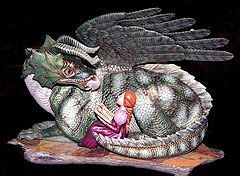
Wandering through the Northwest Wood Carvers’ show recently, I was not the least bit surprised to see one particular carving sitting on the winner’s table festooned with ribbons. That entry, a realistic, painted carving of a nest of bunnies resting amid colorful autumn leaves, grasses and moss, was flawlessly carved from a single block of wood. It was captivating, and the judges thought so, too. The piece took five ribbons in that show, including best of category, best of division, and the coveted best of show, and deserved every one.
Judy Caldwell, the woman who created it, is the quintessential born artist. These days, she just happens to express her art in woodcarving, but long before she picked up chisels, she showed her true colors in two dimensions.
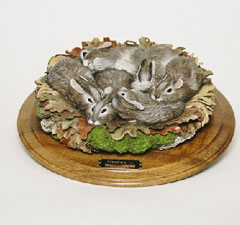
“From as far back as I can remember,” Judy recounted, “I always drew. When I was about five years old, I asked my mom to draw a horse for me. She drew a stick horse, and I said, ‘That doesn’t look like a horse, Mommy.’ I re-drew it to look more like a horse, and have been drawing and painting ever since.”
For Judy, drawing was more necessity than choice. “I just had to,” she told me. “Even when we were too poor to afford paints, I always drew with pencils, paper, or whatever was at hand. Around the age of nine, I started taking art lessons outside of school, and, when they were offered, in school as well.”
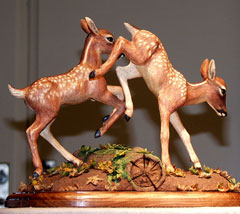
Eventually, she went to the University of Oregon and majored in art education, but dropped out to get married. The marriage lasted and, after 40 years, is still going strong. Along the way, she and her husband produced two daughters, and now boast a granddaughter as well.
An animal lover who owns three horses, two dogs and two cats, she prefers drawing and carving wildlife. “Except for class assignments, I was always drawn to animals, both domestic and wild. That’s mostly what I painted, and what I carve.” Working mostly in acrylics and pastels, she frequently painted dogs, cats and horses for people who wanted portraits of their own animals. She says she prefers to work from a live model rather than a photo because it gives her a sense of the animal’s personality, which shows up in her art.
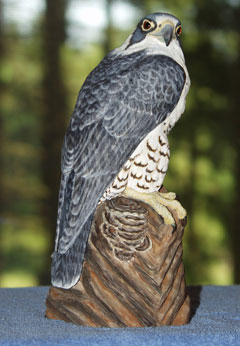
Eventually, the call of wood became too strong to ignore. “The local community college offered a class in woodcarving,” Judy recalled. “For several years I talked myself out of taking the class, even though I wanted to. Finally, in 1989, I ran out of excuses and took a class at Clackamas Community College.
“The teacher was just awful. He had no idea what he was doing. The very first woodcarving I did was a ruddy drake. I rarely do birds, but that’s what was being taught, so that’s what I did. By the end of the class, my piece was better than his.” In spite of the teacher, by the time the class was over, she knew that she was supposed to carve wood.
Since switching to chisels, she’s made quite an impressive showing. She doesn’t keep track of all the ribbons she’s won, but Judy estimates that she has taken more than two dozen first place ribbons, and more than a dozen best of show awards. Her work has even been accepted into the prestigious Audubon show. Along the way, she’s taught and lectured at various carving clubs and guilds, and taught art at the local elementary school.
“When students ask how they can improve the painting on their carvings, I tell them to study flat painting to learn how to create dimension. My painting history translates well onto my carving. When you are painting on a flat surface, you create dimensions with color, and that knowledge carries over. Carving allows you to create in three dimensions, but you can also use color to accentuate those dimensions.”
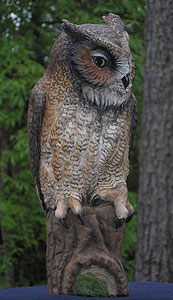
Usually, Judy does models in clay first; her version of sketching before painting. She does it both to work out detail and to develop the dynamics of the animal’s pose. “I’m not a fast carver,” Caldwell said, “so I find that if I work out details in clay, I feel more at ease when I get to wood, since I have already done the piece once in clay. With clay, you can put material back on, but you can’t with wood, so carving is more difficult.” In a sense, she makes each piece twice. Perhaps that explains, at least in part, why her pieces are so superb.
“Lately, I have been studying with Ernie Muehlmatt,” Judy explained, “a well-known artist who carves animals and their habitat from one piece of wood. The nest of bunnies was inspired by his work, and similarly is carved from a single block of wood, including all the moss, leaves, grasses and lichens, as well as the bunnies themselves.”
Her favorite carving is of a fawn lying down on a marble slab. Though you can’t tell from the picture, that carving is life-sized. For Judy, it is the piece that has come the closest to what she wants to say with her work.
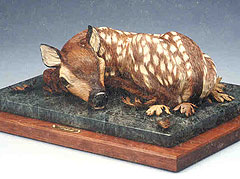
“My art means a lot to me, and I want it to mean a lot to the world. I want people to look at wildlife and realize that we must take care of the animals and their habitat. It is our responsibility to ensure that the environment is fit for those animals who share it with us.”
That says quite a mouthful.





